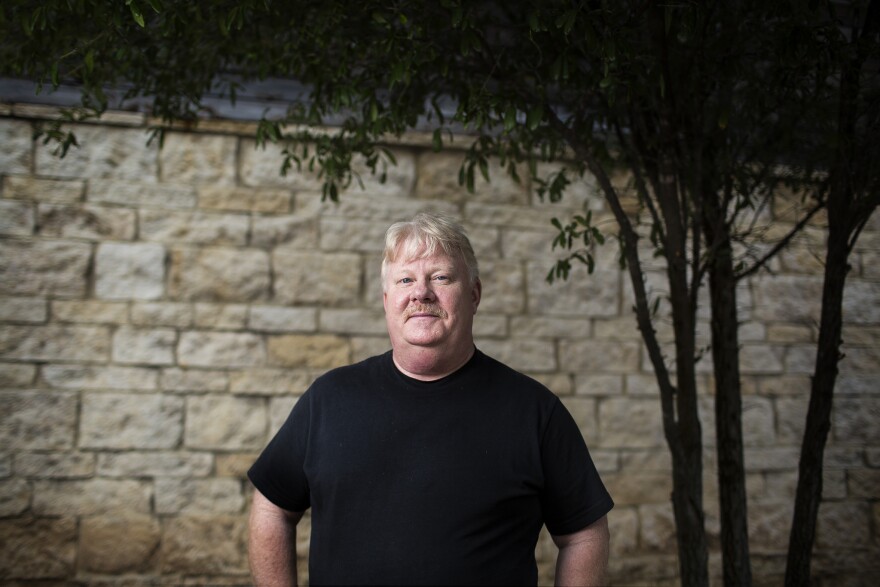This story was originally published on July 31, 2017.
About 85,000 people visit Hippie Hollow every year.
The park on the shore of Lake Travis, just outside Austin, is well-known as a place where you can go to get some sun – without the tan lines. It's thought to be Texas' only clothing-optional public park.
But how did it get that way?
I went out to visit – for the first time – on the day the Hill Country Nudists were holding their annual Big Nude Day at the park. Like on most weekends, dozens of people were lounging in the sun, swimming in the lake and drinking beer (discreetly).

The event’s organizer, Mitch London, is showing me around Hippie Hollow. It’s important to point out that it’s not just “nudists” at the park; there are many more visitors for whom nudity is not a particular lifestyle.
“If you come out here and just sit here and not do anything and not talk to anybody, yeah everybody is going to look at you kind of weird,” London says. “But if you come out here and [say,] ‘Hey, how you doing? I'm new,' or whatever, they’re going to welcome you into this family, basically.”
Most of the people at this particular event are 50-plus. They’ve been coming to Hippie Hollow for decades. There are many younger people in other parts of the park.
“Young people are usually more uptight about their body image,” says Becky Kent. “At this stage, who cares? I’ve done everything I can do. It didn’t work or it did work, you know? Who cares what we look like?”
All but a handful of the people at this part of the park, known as Radio Rock, are not wearing clothes. (Full disclosure: I am wearing shorts and a T-shirt.)
Remember: This is public property, owned by the Lower Colorado River Authority and managed by Travis County. So why is it legal for people to be fully naked at this public park?
Peter Babb, the digital content manager at KUTX, asked about how Hippie Hollow became clothing-optional as part of our ATXplained project. (You can vote for the next question we'll investigate here.)
Use your cursor or open in the YouTube app on a phone or tablet to take a 360-tour of Hippie Hollow.
The Early Days
The LCRA manages the Highland Lakes, including Lake Travis. Back when it dammed up the river and made the lake, it set aside a few spots along the shore for public access. McGregor Park, as Hippie Hollow was officially known, was one of these.
It was basically just wildland, with no trails, bathrooms or parking. Still, people would go down there to swim – sometimes naked. That went on for decades at McGregor, so the legend goes.
And then, the hippies showed up.

“It’s been called Hippie Hollow since I was a child in the '60s,” says Tracy Cluck, a fourth-generation Austinite whose dad was a park ranger. "I’m thinking by '67 everybody knew it as Hippie Hollow."
The park had its share of problems. Neighbors would complain about noise, trash, drugs and people parking on the street. You can find newspaper reports from the 1970s of people getting busted for skinny-dipping.
“Someone would get arrested, they’d have to make bond and there were jury trials,” Cluck, who’s now a lawyer, says. “No one was convicted.”
At a couple points, state lawmakers took notice and tried to do something to stop the nudity. Bills were introduced to outlaw the behavior, but those efforts didn’t go anywhere.
In 1977, neighbors filed a lawsuit to shut down the park. That, too, went nowhere.

Travis County Takes Over
In 1985, Travis County struck an agreement with the LCRA to take over management of Hippie Hollow. When the county took it over, it put in parking and trails and started charging admission.

“They just were going to maintain it. Keep it safe and clean,” says Ken Oden, the Travis County attorney at the time. “There wasn’t a lot of rules. Hardly any rules.”
But the county didn’t say anything about nudity. It was just kind of understood that naked people were going to be there.
'Everybody Knows'
So, what does the law say about being naked in public? Turns out, it’s not just as simple as whether you’re wearing clothes or not.
“It’s not illegal to be naked,” Oden says. “It is illegal to be naked in public, but only if you are reckless about whether or not you would offend or alarm someone else.”
The fact that it's common knowledge that people go to Hippie Hollow to be naked is a defense against an indecent exposure charge.

“The reason they couldn’t successfully prosecute anyone and why it’s legal to be nude there if you want to be is because everybody knows there are naked people swimming there,” Cluck says.
At some point, though, the county decided to make it official. So, it put up a sign.
“To allow the conduct to not be illegal, the county had to put up signs and say, ‘Here’s what’s going on here and here’s what our rules are,’” Oden says. “And that would eliminate the claims that any criminal conduct could be occurring just on the basis of nudity.”
So, why is Hippie Hollow clothing-optional? It’s a mix of tradition, the government’s respect for that tradition — and that you can’t go there without knowing what you’re getting into.
There’s a big sign that basically says: “Naked people ahead.”
What About Children?
There was something that happened in 1995 that could have ended Hippie Hollow’s clothing-optional status: a children’s poster contest. A nudist group held the contest, with the theme of “body acceptance,” as part of an event at Hippie Hollow. A lot of people didn’t quite know what to make of it and worried it might lead to some kind of child exploitation.
While children had long been going to Hippie Hollow, the contest raised some questions about the park.
“So we sort of had to figure out – if the government owns it, operates it, has taken this on ... what are its obligations?” says Oden. In other words, does the county have a duty to keep kids out of Hippie Hollow?
The answer Oden came up with was yes.

To avoid these kinds of situations, the county could have simply scrapped the clothing-optional option. But Oden recommended simply banning anyone under the age of 18 from the park.
So, on July 11, 1995, the Travis County Commissioners voted to put up another sign, this one saying no one under 18 is allowed. But this also came with some controversy.

“We could not figure out a single reason to do that,” says Cluck, who ended up suing the county on behalf of a husband and wife who had been going to Hippie Hollow with their kids.
“There was no data that supported that,” he says. “No children had been molested. In fact, the data was just the opposite. Children were more likely to be assaulted or molested in other parks in Austin.”
The argument in the lawsuit was basically that parents had a constitutional right to pass their values onto their kids, even if their values were nudism or naturism.
They lost, and Hippie Hollow has been 18-plus ever since.
What Normal People Look Like
Back at Hippie Hollow, I’m wrapping up with Big Nude Day organizer Mitch London.
“I came out here first when I turned 40 basically,” London says. “It was kind of my midlife crisis thing. Instead of buying a Corvette or some fancy trip to someplace, I was like, ‘I’m going to go do something different.’ As soon as I did, as soon as the clothes came off, I’m like ‘this is awesome,' and I’ve just gone on since and I haven’t looked back.”

As we look out over the deepening suntans, I ask London why he thinks some people are weirded out by Hippie Hollow.
“In some respect, I think they’re afraid of seeing themselves,” he says. “In the fact that, there is no perfect bodies here. Everybody is the way they are. You’re not going to find supermodels. You might, but it’s not likely. You’re going to find what normal people look like and they’re afraid that if they see that they’re going to be like, 'Oh man, I’m normal.'"
And it seems you’ll keep being able to find all kinds of bodies at Hippie Hollow, as long as the tradition continues.
















